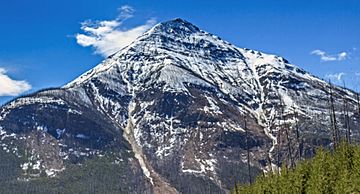Vermilion Peak (British Columbia) facts for kids
Quick facts for kids Vermilion Peak |
|
|---|---|

Vermilion Peak, north aspect
|
|
| Highest point | |
| Elevation | 2,647 m (8,684 ft) |
| Prominence | 448 m (1,470 ft) |
| Parent peak | Mount Ball (3294 m) |
| Geography | |
| Location | Kootenay National Park British Columbia, Canada |
| Parent range | Ball Range Canadian Rockies |
| Topo map | NTS 82N/1 |
| Climbing | |
| Easiest route | Scrambling |
Vermilion Peak is a cool mountain in Kootenay National Park, British Columbia, Canada. It stands about 2,647 meters (8,684 feet) tall! This peak is part of the Ball Range, which is a smaller group of mountains within the huge Canadian Rockies.
The closest taller mountain is Stanley Peak, which is about 2.8 kilometers (1.7 miles) to the east. You can easily spot Vermilion Peak from the Banff–Windermere Parkway as you drive by its base.
Mountain's Story
Vermilion Peak is named after a special red color. East of the mountain, there are beds of ochre along Ochre Creek. The Ktunaxa First Nations people found these ochre beds a long time ago. They used the ochre for trading.
The Ktunaxa would turn the ochre into a red powder called "red oxide." They called this color "vermilion." That's how Vermilion Peak got its name! The name was officially approved on April 3, 1952, by the Geographical Names Board of Canada.
Rock and Formation
Vermilion Peak is made of special rocks called "drag-folded rocks" from the Goodsir Group. These are sedimentary rocks. Sedimentary rocks are formed from layers of sand, mud, and tiny bits of other rocks that get pressed together over millions of years.
These rocks were laid down between the Precambrian and Jurassic periods. Later, during a big event called the Laramide orogeny, these rocks were pushed up and over younger rocks. This is how the mountain range was formed!
Weather at the Peak
Vermilion Peak has an alpine climate. This means it has very cold, snowy winters and mild summers. In winter, temperatures can drop below -20 degrees Celsius (-4 degrees Fahrenheit). With the wind, it can feel even colder, sometimes below -30 degrees Celsius (-22 degrees Fahrenheit)!
The snow and rain that fall on the mountain eventually flow into small streams. These streams then join the Vermilion River.



